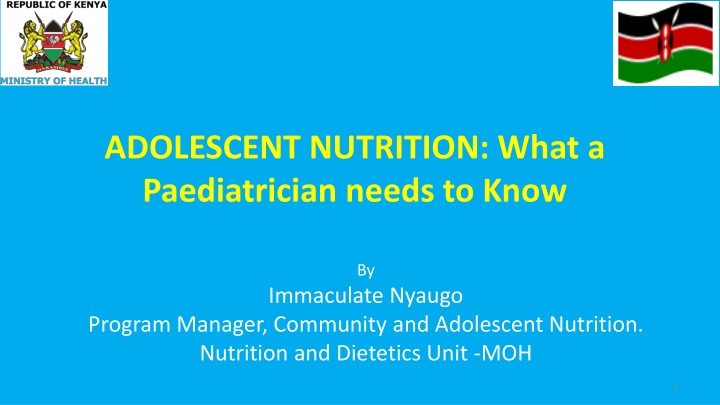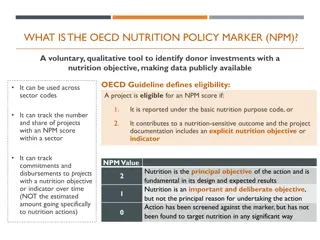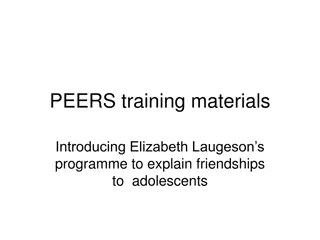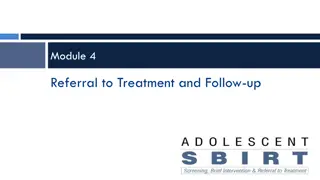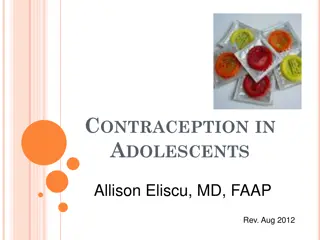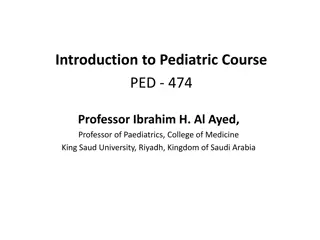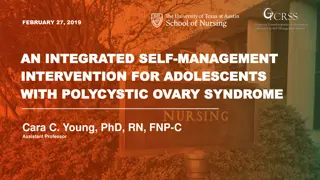Essential Nutrition Guidelines for Adolescents: What Pediatricians Should Know
Adolescents undergo significant physical changes that require specific nutritional needs. Pediatricians should be aware of the increased requirements for energy, proteins, and micronutrients during this crucial stage. Providing nutrition assessment, counseling, and adequate supplementation can help address malnutrition and support healthy development in adolescents.
Download Presentation

Please find below an Image/Link to download the presentation.
The content on the website is provided AS IS for your information and personal use only. It may not be sold, licensed, or shared on other websites without obtaining consent from the author.If you encounter any issues during the download, it is possible that the publisher has removed the file from their server.
You are allowed to download the files provided on this website for personal or commercial use, subject to the condition that they are used lawfully. All files are the property of their respective owners.
The content on the website is provided AS IS for your information and personal use only. It may not be sold, licensed, or shared on other websites without obtaining consent from the author.
E N D
Presentation Transcript
ADOLESCENT NUTRITION: What a Paediatrician needs to Know By Immaculate Nyaugo Program Manager, Community and Adolescent Nutrition. Nutrition and Dietetics Unit -MOH 1
WHY NUTRITION FOR ADOLESCENTS The Adolescence stage there are; Significant increase in height and weight Increase in muscle and fat content Increased nutrients requirements Energy (carbohydrates, healthy fats) Proteins Micronutrients Increased physical activity engagements 2
NUTRITION SERVIVES FOR THE ADOLESCENT NUTRITION SERVIVES FOR THE ADOLESCENT Carry out Nutrition Assessment and Counselling: to identify and classify different forms of malnutrition and provide appropriate counselling. Promotion of dietary diversity, healthy dietary habit, physical activity and consumption of nutrients dense foods. Treat and prevent parasitic infections: deworming of adolescents twice yearly and promotion of prevention mechanism like safe water and sanitation facilities, promoting hand-washing, use of latrines and wearing shoes Provide preventative iron folic acid supplementation: Many adolescents are not likely be able to meet their iron needs through their regular diet alone. Therefore, preventative iron folic supplementation is needed. 3
NUTRITIONAL NEEDS FOR THE ADOLESCENT NUTRITIONAL NEEDS FOR THE ADOLESCENT Proteins and Energy Requirements The requirement of energy (carbohydrates, healthy fats) and proteins increases considerably. The nutrient needs also change depending on the adolescent s physical activity. Protein requirement of an adolescent living in an economically poor environment will be met, as long as they take adequate energy foods. If the energy intake is low, the protein intake is used to meet energy needs. 4
NUTRITIONAL NEEDS FOR THE ADOLESCENT Micronutrient Needs IRON Iron needs are at their highest during adolescence(BOTH BOYS AND GIRLS) due to rapid growth with sharp increase in lean body mass, blood volume and red cell mass. In boys, there is a sharp increase in the iron requirements. This reduces after the growth spurt and sexual maturation In girls, mainly due to menstruation typically starts about one year after peak growth and some iron is lost during menstruation. Iron requirements in adolescence are greater if there are infectious diseases such as HIV, malaria and parasitic infections that can cause iron loss, and because of low bio-availability of iron from diets. CALCIUM needed due to, Increased muscular, skeletal and endocrine development; The mineral quantity in the bone must be optimal during puberty to prevent osteoporosis (risk of fracture/breaking bones in later life). 5
NUTRITIONAL NEEDS FOR THE ADOLESCENT cont. ZINC Important for: Bone formation and prevents bone loss. Physical growth and Sexual maturation (beard, breasts, voice change, etc.) IODINE Important for: Earlier in life severe iodine deficiency in adolescents results in learning disability and lowered achievement. Fetal growth during pregnancy. If inadequate may cause increased miscarriages, still births, birth abnormalities and mental retardation. VITAMINS Needed for: Utilization of energy, the B vitamins help release energy from carbohydrates - Because of higher energy demands Growth and sexual maturation - Folic Acid and vitamin B-12 Prevention of birth defects - Folic Acid Skeletal growth needs more vitamin D. New cell growth needs Vitamins A and C 6
THE KENYAN NUTRITION CONTEXT FOR ADOLESCENTS Contexts and definitions for adolescents vary in Policy different delimitations of age for adolescent Community age is not used to define, social and cultural markers used instead circumcision, marriage and parenthood A large number of adolescents between 14-19 years of age are in boarding schools and may not have control over the foods they are served Vulnerability to peer pressure and media, especially in relation to body image and marketing of food choices/sources. Could result in consumption of excess salt, sugar and/or fats Risky health behaviors such as anorexia nervosa Exposure to and engaging in habits such as smoking, drugs and alcohol use. Could increase the risk of undernutrition/over nutrition and NCDs 7
THE KENYAN NUTRITION CONTEXT FOR ADOLESCENTS Varying household economic status Household income and IGA Social norms and restrictive food practices define the foods adolescents eat or are allowed to eat Poor knowledge on food and Nutrients Educational attainment Climate impacts/determines access to food, especially in Arid and Semi arid areas Security some modes of food access leads to rustling to access food Service delivery issues 8
THE KENYAN NUTRITION CONTEXT FOR ADOLESCENTS MERU A bit of variety in diet cow peas, pea nuts potatoes Girls prepare food when not in school Desire foreign foods, new foods for fashion, satiety and energy spaghetti, chapatti Pregnant adolescent girl viewed as a burden SAMBURU Limited variety in their diets majorly livestock but meat is also rare and mainly consumed during occasions Gradual cultural shift - some now consuming eggs, beans Food experiences food is monotonous/boring Pregnant adolescents/women expected to eat less so that fetus does not grow big Circumcised boys eat meals prepared by their mothers or eat in front of women. Eat in company of a fellow boy Boys expected to eat more and girls less yet girls engage in a lot of chores NAIROBI SLUM Access to food is disorganized, uncertain unregulated Roadside purchase a lot more than home-made meals Hygiene issues- barely washed especially for roadside food Desire the food life of the wealthier neighborhood since they see the food culture from what they scavenge Hustling leads to preference for ready made food 9
NUTRITION DEFICIENCIES AMONG ADOLESCENTS IN KENYA Anaemia among school age children (5-14 years) is 16.5%, iron deficiency 9.4% and iron deficiency anemia is 5% Anemia among 15-19 year old adolescents is 13.8%, iron deficiency 15.6% and Iron Deficiency Anaemia is 7.6% Zinc deficiency among school age children (5-14 years) is 80% 18% of adolescents get pregnant Folate and vitamin B12 deficiency is 31.5 and 47.7% respectively among non pregnant women 15-19 years Smaller studies indicate an increase in number of adolescent overweight and obese ad an increase in diet related NCDs (Data from the Kenya National Micronutrient Survey 2011 ) 10
Thank You Thank You 11
